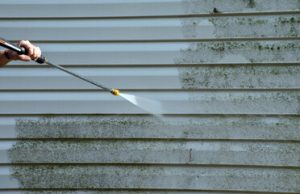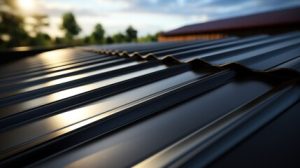Pressure Washing Services are one of the most effective ways to keep your commercial building or residence clean. But the water used for this process can damage surfaces if not properly regulated.

It’s important to hire a professional. They’ll know how to vary the psi and water flow on different surfaces, so they don’t damage them.
As a homeowner, it’s important to keep your property in excellent condition. Keeping your home clean and free of stains, mildew, mold and other unsightly substances shows potential buyers that you take pride in your property and are committed to maintaining its value.
In addition, regular pressure washing can help prevent long-term surface damage. Algae, dirt, mildew, and grime are more than just unattractive; they break down paint, wood, siding, and sealants, leading to rot, warping, and early replacement. Pressure washing can also improve your energy efficiency, as dirt and grime clinging to your roof, windows, and gutters block sunlight from warming your home’s interior.
Moreover, pressure washing eliminates the need for time-consuming elbow grease. Instead of scrubbing away at stubborn stains with a brush and bucket, professional pressure washers can quickly blast surfaces with high-velocity water streams, lifting even the most persistent dirt and grime without the need for harmful chemicals. Additionally, trusted professionals know the appropriate pressure levels and cleaning solutions to use for each type of surface.
The resulting clean, beautiful surfaces are perfect for repainting and staining projects, maximizing their longevity and enhancing visual appeal. In fact, many real estate agents recommend a good power wash and needed painting touch-ups prior to putting your property on the market.
Finally, regular pressure washing will help you keep your home and outdoor living spaces safe. Dirt, mold, and mildew can cause a wide range of health issues, from eye irritation to respiratory problems. Pressure washing removes these contaminants and keeps them from spreading, helping to preserve your family’s health.
Whether you are looking to uphold your property’s value or prepare to sell it, professional pressure washing services can make all the difference. Avoid the costs of repairs and replacements by scheduling routine cleanings throughout the year. Spring and summer are great times to schedule cleanings, removing all of the pollen, mold spores, and bird droppings that pile up during this busy season. Autumn and winter cleanings can also be helpful, removing the sap, leaves, and moss that collect on your exterior walls and roof.
Eliminates Dirt and Mold
Dirt, mildew and mold buildup not only ruins the appearance of your home’s exterior surfaces, but it also poses a health hazard. These contaminants can irritate sensitive skin and eyes, and even cause respiratory issues. Professional pressure washing services use high-powered water and cleaning solutions to blast away these dangerous substances, leaving surfaces clean and free of harmful growths.
Aside from keeping your home clean, regular pressure washing also helps to eliminate the food sources that mold and mildew need to thrive. These food sources include leaves, grass cuttings, flower petals and other organic debris that collect on outdoor surfaces. When these materials break down, they release nutrients that feed mold and mildew, causing them to grow. Professional power washing eliminates these organic materials and prevents future mold and mildew growth, preserving your home’s value and ensuring that your family is safe.
Mold and other organic growths don’t just stick to your home’s exterior, but they can also accumulate on outdoor furniture and play equipment. These materials can be a tripping hazard and are a safety risk for children and pets. Routinely cleaning these areas with a pressure washer removes the dirt, grime and other debris that can lead to accidents and injuries.
The high-powered water pressure used in a power washer loosens grime and allows it to be easily removed with the right cleaning solution. The force of the water is strong enough to penetrate cracks and pores in many different types of surfaces. The heated water in a professional power wash makes it especially effective at breaking down oil stains and other tough deposits.
A building’s exterior is often the first impression that customers have of your business. Maintaining a clean business reflects well on your company and sends a message to potential customers that you take pride in your establishment. Professional power washing services utilize high-powered water with a wide range of cleaning solutions to eliminate dirt, grime and other unwanted material from various exterior surfaces, including walls, fences, roofs and patios.
Regular pressure washing can protect your commercial property’s exterior from the elements, preserving its appearance and boosting its curb appeal. Power washing can also make your building’s entrance more welcoming for your customers and staff.
Promotes a Healthier Living Environment
Over time, a property can accumulate dirt, grime, mildew, mold and other unsightly elements that detract from its appearance. Professional pressure washing services remove these contaminants and restore surfaces to their original beauty, protecting them from damage and extending their lifespan.
Aside from boosting curb appeal, regular pressure washing of a home or business enhances overall health and wellbeing by eliminating harmful pollutants that settle on outdoor surfaces. Airborne pollutants can deteriorate composite siding, wood decking and other exterior materials over time, leading to costly repairs. Pressure washing strips away these pollutants to preserve the integrity of exterior structures and safeguard indoor air quality.
Dirt, grime and other contaminants that accumulate on a home’s exterior can contribute to a variety of health issues, particularly for those with allergies or respiratory conditions. In addition, slippery surfaces caused by algae or mold growth pose a safety hazard for children and adults, increasing the risk of slips and falls. Pressure washing eliminates these hazardous substances to create a safe environment for the family and guests.
When hiring a professional to power wash your home, be sure to ask the right questions to ensure that they are qualified and insured. One mistake could put your property at risk of damage, so it’s crucial to hire a company that is well-versed in pressure washing and can handle the job safely and efficiently.
Hiring a professional to pressure wash your home or commercial property is an investment that protects your assets, improves your quality of life and boosts your property’s value. As the summer season arrives, be sure to give your home or business a fresh look with expert cleaning services from EcoWash! Contact us today to schedule a free consultation. We’re proud to provide high-quality pressure washing and a range of eco-friendly cleaning solutions for homes and businesses in the Dallas-Fort Worth area. We’ll keep your property clean and looking its best all year round. You can trust our experienced team to handle any cleaning job, big or small. Our professionals use only environmentally-friendly cleaning products and are trained to operate a wide array of pressure washing equipment.
Reduces Slippage
In addition to enhancing curb appeal and extending the life of exterior surfaces, professional pressure washing can greatly reduce slip-and-fall accidents and injuries. Algae, mildew, and mold can easily cover decks, patios, and sidewalks, presenting potential health risks, visual impairments, and slip hazards for pedestrians and residents. Pressure washing blasts away these unsightly growths and dries surfaces, eliminating moisture levels that encourage future growth. Aside from removing hazardous contaminants, properly handling and operating a pressure washer is critical for preventing injury. Experienced cleaning professionals like APS follow strict safety protocols, ensuring that the cleaning area is secure from tripping or obstructed areas and that all pressure-washing equipment works properly.
Keeping a commercial building or parking lot clean can also boost your reputation and enhance the value of your property. In a busy world where customers and employees are constantly on the move, maintaining a spotless property speaks volumes about your business’s attention to detail and commitment to customer satisfaction.
Additionally, a clean business is a safer work environment. Pollen, dirt, dust, mildew, bird droppings, and oil stains can all lead to harmful health consequences including breathing difficulties, allergies, and diseases. Pressure washing removes these substances and, when done regularly, prevents their re-growth.
Whether you own a home or manage an office building, having your property professionally pressure washed is one of the best investments you can make. It not only improves curb appeal and extends the life of exterior surfaces, but it can also significantly enhance the safety and health of your family or employees. Contact the professionals at APS to learn more about how regular professional pressure washing can help protect your property’s value and enhance your quality of life. We offer a wide range of residential and commercial cleaning services, and our extensive portfolio is backed by more than two decades of industry experience and a commitment to complete customer satisfaction. Contact us today to schedule your free consultation! We proudly serve the Atlanta and surrounding areas.



